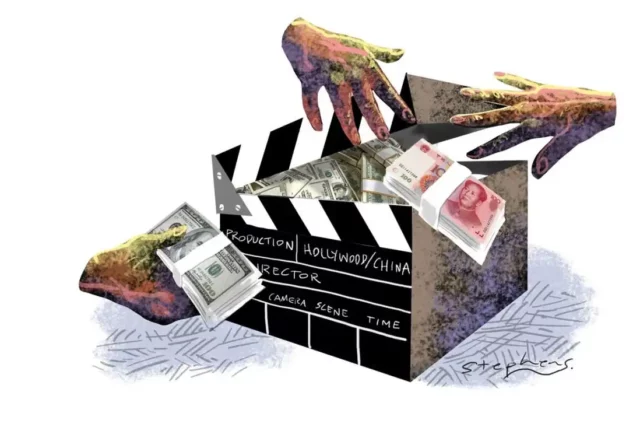Many of us like nothing more than to escape the real world for an hour or two by kicking back and getting into a Hollywood blockbuster movie. But few, if any, understand the complex and challenging financing that made it possible in the first place.
Movie financing is a risky business. Some films make mega bucks. Others bomb at the box office and disappear into obscurity. Despite the potential for huge financial losses, investors continue to put their faith in the Hollywood movie machine and back it up with financial support. So, let’s take a journey behind the scenes of Hollywood movie financing and find out what it’s all about.
Table of Contents
Who Finances Movies?

Most people don’t realize how much it costs to make a feature film. Big-budget movies cost, on average, around $100 million to make, although this figure can be much higher in some cases.
Even fewer people outside the business understand the complex process of movie financing. This is because film funding appears to be unique – unlike any other type of financing.
Film financing comes from various sources. The most common are the major studios like Warner Bros and Disney, which provide funding in return for distribution rights. Other sources include distributors, production houses, private investors, independent financiers, and filmmakers themselves.
Investing in a movie can be lucrative, with undertones of glamor, but it comes with a high level of risk. Investors have a lot to think about before parting with their cash, including the producer’s reputation and experience, the quality of the cast, the appeal of the script or screenplay, and whether the movie will attract a wide audience.
How Are Movies Financed?
Filmmaking is an expensive business, with budgets up to a staggering $400 million. More than a billion film fans flock to movie theaters each year. However, most of us remain in the dark about how films are financed.
Films are financed in 3 main ways:
• Equity finance. Investors provide capital in exchange for a stake in the film company.
• Debt financing. Investors lend money and charge interest on the loan.
• Financial aid such as grants or tax breaks.
What Are Film Financing Companies?
The movie industry is a cutthroat business. It can be difficult to get funding, particularly without a proven track record. That’s where film financing companies come in. Film finance organizations invest in a movie in return for profit or shares.
These companies often play the most significant role in a film’s production and are key to getting a film off the ground and into theatres. They’re not only the source of funding but also help with marketing and distribution.
Hard Money And Soft Money In Movie Financing
Movie financing often comes in the form of hard money or soft money.
Hard money refers to external funding and often comes from a lending organization. These lenders may require little or no collateral. However, they charge higher interest rates to mitigate the risk of borrowers defaulting on the loan.
Soft money is provided within the business – from a studio or distributor, for instance – regardless of the film’s ability to make a profit. Soft money doesn’t have to be repaid. Instead, investors wait until the film is released before making any gains from it. Soft-money examples include product placement and location incentives.
Can Filmmakers With Bad Credit Get Financing?

Lenders outside Hollywood invariably take credit history into account when considering a loan application. Ideally, they want to lend money to a business or individual with a good credit rating because they’re less of a risk. This is why people take steps to repair bad credit.
It might surprise you to learn that this isn’t the case with lenders who finance films. They pay no heed to a borrower’s credit score. And while bad-credit movie financing may be secured against assets and come with high-interest rates, it can be written off if the film makes a loss.
What Are The Hidden Costs Of Making A Movie?
If film fans think about movie costs at all, they probably focus on things like CGI (computer-generated imagery) and other spectacular special effects. But there are many other major costs, including the script, cast, and staff salaries, and marketing.
On top of these expenses, there may well be hidden costs that are difficult to quantify. Common sources of these costs include:
• Transportation, especially if a movie is being filmed across multiple locations.
• Catering.
• Film music.
• Insurance.
• Fixing errors in post-production.
How Much Do Hollywood Movies Make?
Hollywood is a big business, with movies making billions of dollars a year. Some blockbusters hit the jackpot with an outstanding return on investment. James Cameron’s Avatar (2009), for example, had grossed $2.9 billion by 2023, and his Titanic (1997) has earned $2.2 billion.
Many movies, however, don’t make enough to justify the expense. One of the most notorious box-office flops in Hollywood history was John Carter (2012). One of the costliest films ever made, this Disney sci-fi action flick had to seriously deliver at the box office. It didn’t. It bombed, losing an eyewatering $200 million dollars.
Get Shorty: A Loan Shark’s Adventures In Hollywood!

Starring a host of stellar names such as John Travolta, Gene Hackman, Danny DeVito, and Rene Russo, the gangster comedy thriller Get Shorty (1995) earned Travolta a Golden Globe award and grossed $115 million at the box office.
Ironically, the movie mercilessly satirized the world of Hollywood, painting a picture of overinflated egos clashing in the endless pursuit of feature film production money.
It all kicks off when Miami mafia loan shark Chili Palmer (Travolta in a memorable performance) gets involved in movie production after producer Harry Zimm (Gene Hackman) gambles away $200,000 worth of investors’ money. Talk about bad credit!
After this, though, observers say Get Shorty got much about Hollywood right, including the endless jockeying for status from studio heads down.
Final Words
Tinseltown remains the film capital of the world. Despite the financial risks of filmmaking, Hollywood movies keep coming, and we keep watching them.
More than 44 percent of the adult U.S. population goes to the movie theater at least once a month, and 85 percent of households now have at least one subscription to a video streaming service such as Netflix.
Now we’ve had a glimpse behind the scenes of movie financing, with all its complexities, perhaps we should spare a thought occasionally for the people willing to plow money into the business so we can continue to enjoy Hollywood blockbusters in all their spectacular glory.


